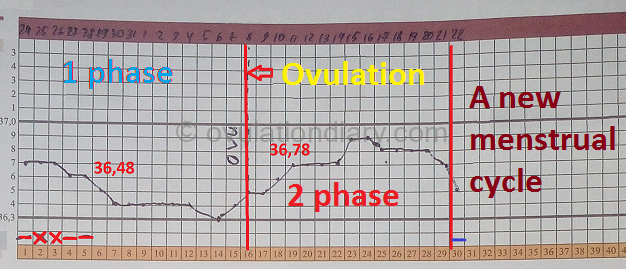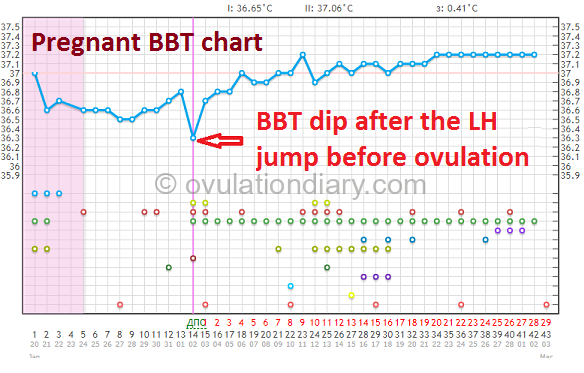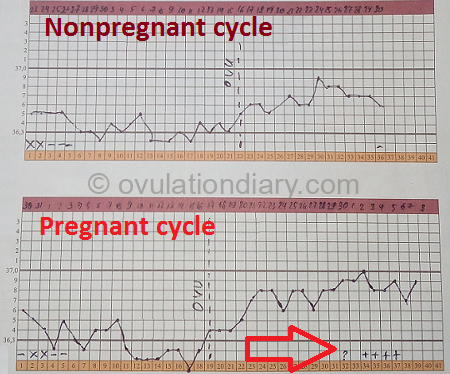
The basal body temperature is the body temperature at rest, in the morning just after waking up. Its indicators during a monthly cycle change is in accordance with estrogen and progesterone fluctuations in a woman’s body. If there is ovulation, then the difference between the phases before ovulation and after it is from 0.3 to 0.5 Celcius degrees or 0.54–0.9 °F. What matters is not absolute values (e.g. 37 °C or 98.60 °F), but relative (for example, the difference between 36.2 and 36.6 °C or 97.16 and 97.88 °F).
Basogram is a good, indicative, and most importantly an inexpensive home way to determine if ovulation occurs or not. Pregnancy without it is impossible. The duration of measuring BBT is three cycles at the same time or more. The main plus is you don’t need money (a normal mercury thermometer is enough).
A woman’s normal basal body temperature
Estrogen and progesterone are two major female hormones that promote fertility (ability to conceive) and maintain pregnancy. Each of them prevails in a certain phase of the cycle and affects the basal temperature.
- estrogen – reduces
- progesterone – increases
Estrogen begins to grow in the first phase, immediately after menstruation and reaches its maximum shortly before the follicle rupture. BBT all this time is lowered. After ovulation, a yellow body is formed (produces progesterone) and the indicators increase relative to the first phase.
Here’s an example of my non-pregnant BBT chart:

The normal basal temperature before ovulation and after it differs by about 0.4 °C (0.72 °F). For example, in the first phase of the cycle – on average – 36.6 °C (97.88 °F), in the second phase – 37.0 °C (98.60 °F). Or, 36.4 °C (97.52 °F) before ovulation and 36.8 °C (98.24 °F) after it.
How to measure the basal body temperature?
Usually, the basal body temperature is the most indicative after a deep sleep. It is measured in three ways:
- In the mouth (orally);
- Vaginally ;
- In the buttocks (rectally).
There is no definition of which one is the most correct and accurate. Each way is informative and a woman chooses the most convenient for her. In this article (on ovulationdiary.com), I compare the advantages and disadvantages of each measurement ways.
Classically, the most common way of measuring is in the rectum.
![]() Attention (!): You can’t change the way of measuring BBT, because at the same time its indicators differ depending on the place of measurement. In the mouth, for example, the temperature is lower than in the rectum by 0.2 °C (0.36 °F).
Attention (!): You can’t change the way of measuring BBT, because at the same time its indicators differ depending on the place of measurement. In the mouth, for example, the temperature is lower than in the rectum by 0.2 °C (0.36 °F).
Measurements should be taken daily at approximately the same time and recorded on the chart. The type of thermometer does not matter. It can be electronic or mercury.
Mercury is more sensitive and accurate. It is easy to clean but also easy to break.
Electronic is safe and fast, but less sensitive, so the curve is very flat.
I recommend reading this article where I compare two types of thermometers: electronic and glass.
Measurement rules of the basal body temperature
To find out the accurate basal temperature, which is not distorted by external factors, you will need to follow these 7 conditions:
- Take your temperature at the same time.
- Use the same thermometer (sensitivity can be different).
- You should have had at least 3 hours of deep sleep (6 is better)
- Don’t get out of bed and roll over before taking your temperature.
- Don’t open your mouth and talk (if taking the BBT orally).
- Don’t measure a specific area of the body that has a disease. For example, with hemorrhoids exacerbation, the rectal temperature will be increased;
- To keep the thermometer in the mouth under the tongue for 8 minutes, rectally and vaginally – 5 minutes.
Temperature changes to determine ovulation
When calculating a favorable period for conception, you need to know what the basal temperature should be before ovulation.
Egg release initiates a powerful release of luteinizing hormone (LH) and a jump in estrogen. This hormone lowers the basal temperature by 0.2-0.4 °C (0.36–0.72 °F). The fall of BBT suggests that there will be ovulation in the next 6-48 hours. However, the symptoms are not seen in all women or all cycles.

If you notice a characteristic behavior of BBT you can confirm your guess about ovulation coming in the following ways:
- LH test (test strip will be as bright as control);
- ultrasound folliculometry (there is a dominant follicle 18-22 mm);
- tracking the consistency of discharges (will be like crude protein) and in other ways.
![]() Note (!): I like and trust the BBT measurement method very much. When planning a pregnancy according to charts, the doctor immediately sees if there are ovulation and a possible imbalance of hormones. After studying several charts at the same time, you begin to understand how the female body behaves in the coming period before and after ovulation. And it is easier to determine the approximation of the fertility period.
Note (!): I like and trust the BBT measurement method very much. When planning a pregnancy according to charts, the doctor immediately sees if there are ovulation and a possible imbalance of hormones. After studying several charts at the same time, you begin to understand how the female body behaves in the coming period before and after ovulation. And it is easier to determine the approximation of the fertility period.
After all, it is a day or two before ovulation and on the day of ovulation that is more likely to get pregnant. Intimacy during this period will increase your chances of a successful conception.
What does the BBT chart look like?
To make a chart, it is necessary to measure BBT daily and make appropriate points and findings:
- daily temperature indicators (days without measurements leave empty);
- menstrual bleeding;
- the nature of cervical mucus;
- chest and abdominal pain
- other factors that may affect BBT (the SARS, go to bed late, poor sleep, etc.)
Next, the temperature points are connected in a line and a BBT chart is obtained. So many additional parameters are required to learn how to find complex confirmation of ovulation, on several symptoms at once.
![]() For example (!): during planning: a basal body temperature that suddenly fell by 0.2-0.4 °C (0.36–0.72 °F), the nature of the discharge changed, pulling pains appeared in the ovaries or the abdomen, perhaps a few drops of blood (not necessarily). All this can indicate the beginning of the fertility period of a woman.
For example (!): during planning: a basal body temperature that suddenly fell by 0.2-0.4 °C (0.36–0.72 °F), the nature of the discharge changed, pulling pains appeared in the ovaries or the abdomen, perhaps a few drops of blood (not necessarily). All this can indicate the beginning of the fertility period of a woman.
How to indicate pregnancy with BBT?

In short: if elevated BT lasts more than 14-16 days, this may indicate a possible pregnancy. Everything depends on the duration of the lutein phase of a particular woman.
For example, my normal basal temperature is increased for 12 days and then falls two days before menstruation (you can see on this chart). And suddenly high BBT remains for 13 days past ovulation (DPO) – this is a reason to think and … to take a pregnancy test!

There are 4 such symptoms. By simply observing the chart in normal, non-pregnancy cycles it is possible to determine pregnancy even up to menstruation by the absence of temperature drop, implantation retraction and other characteristic changes of basogram.
